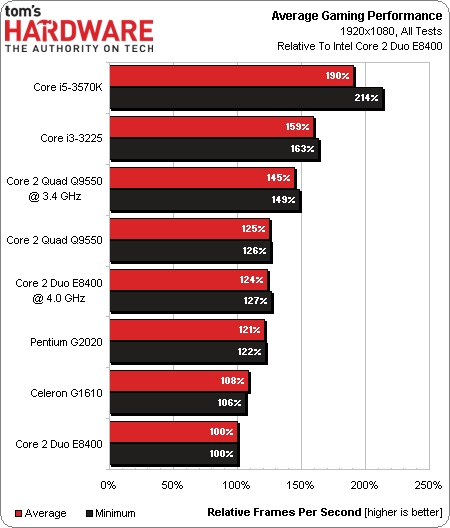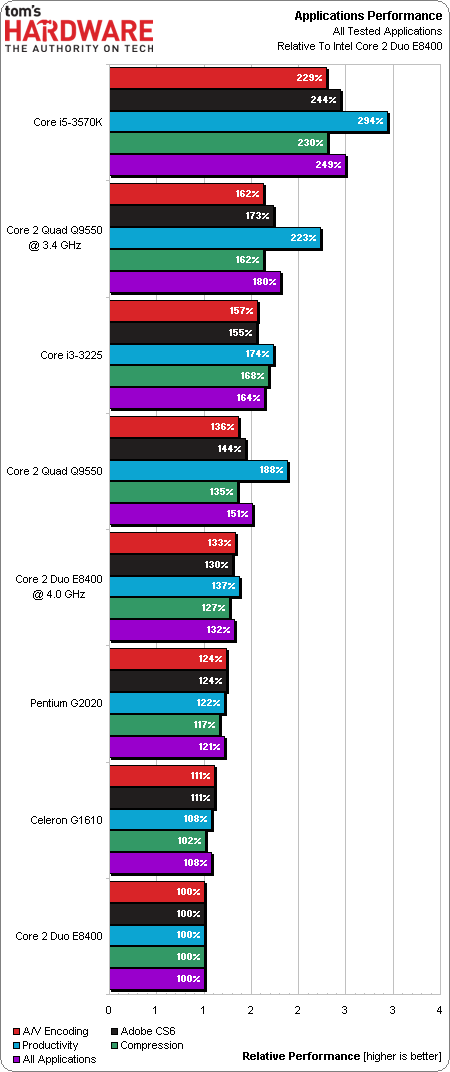Is This Even Fair? Budget Ivy Bridge Takes On Core 2 Duo And Quad
Reader requests affect much of the work we do, and we constantly receive email asking for this one: compare Intel's older Wolfdale- and Yorkfield-based designs against today's budget-friendly Ivy Bridge-based processors. Well, you asked, and we deliver.
Performance Summary
Let’s summarize our performance testing, and try to pinpoint how these various chips stack up to one another. Of course, what matters more than the averages is how they perform in the apps most important to you.
Was anyone surprised by the potency of the little Celeron G1610? It beat out the Core 2 Duo E8400 by 8% in both games and applications, placing it directly between the Core 2 Duo E8500 and E8600! Our in-store purchase was a real bargain, but this helps explain why the street price is often inflated.
Equally impressive is how well the Pentium G2020 performs, outpacing the E8400 by 21%, despite a 100 MHz-lower clock rate. That’s a solid showing for a $50-65 chip, even if the lack of overclocking support means you'll never get anything extra out of it.
On the other hand, overclocking is why we came to know and love Intel's Wolfdale design. Pushed to 4.0 GHz, our Core 2 Duo E8400 out-gamed the Pentium G2020 by 1.9% in average FPS, and by 4.0% in absolute minimum FPS. Its lead in applications was slightly higher still. Had we instead tested a Pentium G2120, with a 6.9% speed bump, gaming would likely have swung back in favor of Ivy Bridge.
Core 2 Quad Q9550 out-gamed the Pentium G2020 by only 3.3% in both average and minimum frames per second. More than likely, a Pentium G2120 would match the Q9550, while the G2020 we tested could hang in there with a Core 2 Quad Q9400. Of course, things are rarely this simple, and the outcome will almost always depend on the specific game in question. The most well-threaded titles we tested favored the Core 2 Quad architecture.
So what happens if we pull out Skyrim and StarCraft 2, the Pentium processor's strongest showings, since those two titles gain little to no benefit from more than two cores? Looking at only the highest playable settings for our (overpowered) Radeon HD 7970 paired with either chip, the Core 2 Quad Q9550 only held a 9% lead, which is far less than we expected. And in older titles, the Pentium would likely come out on top. Of course, everything changes once we overclock, but with such a small advantage favoring the stock Q9550, I’m left wondering how my overclocked Kentsfield-based Q6600 at 3.0 GHz compares to the affordable and power-friendly Pentium G2020.
Thankfully, applications continue to be better-optimized for multiple cores, and not one of our dual-core chips gets an advantage in productivity-oriented titles. Older quad-core processors like the Core 2 Quad Q9550 still pack a decent punch, even besting the new Ivy Bridge-based Core i3-3225 in a few of our benchmarked applications. Once we factor in overclocking, the locked-down Core i3 falls behind in every threaded title.
Get Tom's Hardware's best news and in-depth reviews, straight to your inbox.
But gaming introduces other platform demands, and doesn't always benefit from threading the same way as content creation titles do. The Core i3-3225 simply dominates in this discipline. Once we overclock to 3.7 GHz, though, our E0-stepping Core 2 Quad is able to compete against the Ivy Bridge-based Core i3, and it even wins in three out of eight gaming titles. In short, if you already have a high-clocked Core 2 Quad, then Core i3 is not worth upgrading to based on performance alone.
Current page: Performance Summary
Prev Page Power Consumption Next Page How Do Five-Year-Old CPUs Hold Up Against Ivy Bridge?-
ASHISH65 Wow! this is the review i am waiting from long time.Really good one for budget gamers.Reply -
DarkSable Now this is cool stuff.Reply
Also, amoralman, did you read this? It's basically assuring you that your C2D is still awesome as a budget processor. -
Steelwing Very nice review! I've got a C2D E6600 (2.4 GHz) and had been considering the Core i5-3570K (or possibly wait for a Haswell i5) and was wondering about the performance differences. My CPU is still good for a lot of apps, but I can definitely see a reason to upgrade.Reply -
AMD Radeon pentium dual core G2020 is the minimum i can recommend to budget gamers. i often listed it in sub 450 gaming PCReply -
lpedraja2002 Excellent article, I'm glad I have a more accurate idea on where I stand based on CPU performance, I'm still using my trusty Q6600, G0 @ 3.2ghz. Its good that Tom's still hasn't forgotten that a lot of enthusiast still are rocking Core 2 architecture lol. I think I can manage until Intel releases their next revolutionary CPU.Reply -
assasin32 I been wanting to see one of these for a long time but never thought I get to see it. I just wish they had the good ol e2160, and q6600 thrown into the mix. I have the e2180 OC to 3ghz. It's still chugging along surprisingly enough, I just realized how old the thing was last night after thinking about how long I've had this build and looking up when the main components were produced. Safe to say I got my use out of that $70 cpu, did a 50% OC to it :) and it still had room to go but I wanted to keep the voltage very low.Reply -
jrharbort I've always been curious about how well my own Core 2 Duo P8800 (45nm & 2.66GHz) would stand up against modern ivy bridge offerings. And even though I'm talking about he mobile space, I'm guessing the gains would be comparable to those seen by their desktop counterparts. Each day I'm reminded more and more that I seriously need to move on to a newer system, especially since I work with a lot of media production software. Thanks for the article, it provided some interesting and useful insight.Reply -
smeezekitty Kind of interesting that the old Core 2s beat the I5 in tombrader with TressFX on.Reply
Also holy crap on 1.45 vcore on the C2D -
Proximon I would not have predicted this. Not to this extent. I hope we can make these broader comparisons across years more frequently after this. I predict this will be a very popular article.Reply

